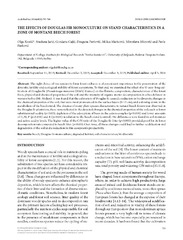Приказ основних података о документу
The effects of Douglas fir monoculture on stand characteristics in a zone of Montane beech forest
| dc.creator | Kostić, Olga | |
| dc.creator | Jarić, Snežana | |
| dc.creator | Gajić, Gordana | |
| dc.creator | Pavlović, Dragana | |
| dc.creator | Marković, Milica | |
| dc.creator | Mitrović, Miroslava | |
| dc.creator | Pavlović, Pavle | |
| dc.date.accessioned | 2017-11-23T11:30:34Z | |
| dc.date.available | 2017-01-12T13:34:40Z | |
| dc.date.issued | 2016 | |
| dc.identifier.issn | 0354-4664 | |
| dc.identifier.uri | http://www.doiserbia.nb.rs/Article.aspx?ID=0354-46641600032K | |
| dc.identifier.uri | https://radar.ibiss.bg.ac.rs/handle/123456789/2486 | |
| dc.identifier.uri | https://www.scopus.com/record/display.uri?eid=2-s2.0-85003007218&origin=SingleRecordEmailAlert&dgcid=scalert_sc_search_email&txGid=FBB4104D27B7BC3C905C7DEC47444824.wsnAw8kcdt7IPYLO0V48gA%3a76 | |
| dc.description.abstract | The right choice of tree species to form forest cultures is of paramount importance to the preservation of the diversity, fertility and ecological stability of forest ecosystems. To that end, we examined the effect of a 40-year-long cultivation of Douglas fir (Pseudotsuga menziesii (Mirb) Franco) on the floristic composition, characteristics of the forest floor, physical and chemical properties of the soil and the intensity of organic matter decomposition in a beech forest in western Serbia (Mt. Maljen). It was found that the cultivation of Douglas fir caused a reduction in biodiversity, changes in the chemical properties of the soil, that were most pronounced in the surface layers (0-10 cm), and a slowing down in the metabolism of the beech stand. The absence of many plant species characteristic to natural beech forests was observed in the Douglas fir plantation, these were reflected in the detected changes in the chemical properties of the soil, such as lower substitutional acidity (p<0.05), depletion of the adsorption of basis in the cation complex (p<0.001) and lower amounts of C, N, P (p<0.001) and K (p<0.01) in relation to the beech stand (control). No differences were found in soil moisture and active acidity levels. The higher value of the C/N ratio of the Douglas fir litter (p<0.001) provided proof for its lower decomposition rate compared to beech litter (p<0.05). Over time, all these changes could lead to further acidification and degradation of the soil and a reduction in this ecosystem's productivity. | en |
| dc.relation | info:eu-repo/grantAgreement/MESTD/Basic Research (BR or ON)/173018/RS// | |
| dc.rights | openAccess | |
| dc.rights.uri | https://creativecommons.org/licenses/by-nc-nd/4.0/ | |
| dc.source | Archives of Biological Sciences | |
| dc.subject | Beech | |
| dc.subject | Douglas fir monoculture | |
| dc.subject | Degraded habitat | |
| dc.subject | Soil characteristics | |
| dc.subject | Biodiversity | |
| dc.title | The effects of Douglas fir monoculture on stand characteristics in a zone of Montane beech forest | en |
| dc.type | article | |
| dc.rights.license | BY-NC-ND | |
| dcterms.abstract | Марковић, Милица; Костић, Олга; Јарић, Снежана; Павловић, Павле; Павловић, Драгана; Митровић, Мирослава; Гајић, Гордана; | |
| dc.rights.holder | © 2016 the Serbian Biological Society | |
| dc.citation.issue | 4 | |
| dc.citation.volume | 68 | |
| dc.description.other | Archives of Biological Sciences (2016), 68(4): 753-766 | |
| dc.identifier.doi | 10.2298/ABS150911032K | |
| dc.identifier.scopus | 2-s2.0-85003007218 | |
| dc.identifier.wos | 000389771500006 | |
| dc.citation.vancouver | Kostić O, Jarić S, Gajić G, Pavlović D, Marković M, Mitrović M, Pavlović P. The effects of Douglas fir monoculture on stand characteristics in a zone of Montane beech forest. Arch Biol Sci. 2016;68(4):753–66. | |
| dc.citation.vancouver | Kostić, O., Jarić, S., Gajić, G., Pavlović, D., Marković, M., Mitrović, M., & Pavlović, P. (2016). The effects of Douglas fir monoculture on stand characteristics in a zone of Montane beech forest. Archives of Biological Sciences, 68(4), 753–766. | |
| dc.citation.spage | 753 | |
| dc.citation.epage | 766 | |
| dc.type.version | publishedVersion | en |
| dc.identifier.fulltext | https://radar.ibiss.bg.ac.rs//bitstream/id/3451/ArchBiolSci_2016_68_4_753-766.pdf | |
| dc.citation.rank | M23 |

